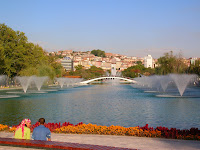 Thursday 29 October: Bus with Rita, Matt and Ivan to Shiraz and the Sasan Hotel. Explored Shiraz with Ivan, an affable Hong Kong police officer with two-weeks holiday in Iran: Rouzbahan Tomb, Karimkhan Castle with its leaning tower, Eram Palace Gardens, the Military Museum housed in the shah's former palace surrounded by Affifabad Garden with it's tilled teahouse depicting ancient legends. A local 22 year old Iranian computer technician, proud of his city, gave us his time and paid all our taxi and entrance fees, he wouldn't accept a penny, and we really tried - this is typical Iranian hospitality. Day trip with the guys in Moses' car to see the full glory of Persia's 400 BC Achaemenid empire at Persepolis (UNESCO World Heritage Site), and also Sassanian bas-reliefs at Naqsh-e Rajab and rock-carved tombs at Naqsh-i Rustam. Ended the day with a farewell 'wild night' dinner at Sharzeh Traditional Teahouse with folk music, fine food and wine glasses brimming with Sharaz's finest. Said goodbye to Ivan, Hong Kong Rita who is flying to Egypt then back to India, Nepal and mainland China and Canadian Matt who is heading for India.
Thursday 29 October: Bus with Rita, Matt and Ivan to Shiraz and the Sasan Hotel. Explored Shiraz with Ivan, an affable Hong Kong police officer with two-weeks holiday in Iran: Rouzbahan Tomb, Karimkhan Castle with its leaning tower, Eram Palace Gardens, the Military Museum housed in the shah's former palace surrounded by Affifabad Garden with it's tilled teahouse depicting ancient legends. A local 22 year old Iranian computer technician, proud of his city, gave us his time and paid all our taxi and entrance fees, he wouldn't accept a penny, and we really tried - this is typical Iranian hospitality. Day trip with the guys in Moses' car to see the full glory of Persia's 400 BC Achaemenid empire at Persepolis (UNESCO World Heritage Site), and also Sassanian bas-reliefs at Naqsh-e Rajab and rock-carved tombs at Naqsh-i Rustam. Ended the day with a farewell 'wild night' dinner at Sharzeh Traditional Teahouse with folk music, fine food and wine glasses brimming with Sharaz's finest. Said goodbye to Ivan, Hong Kong Rita who is flying to Egypt then back to India, Nepal and mainland China and Canadian Matt who is heading for India.Sunday 1 November: Visited mausoleum of revered Iranian poet Havez, Jahan Nama Garden and bumped into Joules again on his way to Tehran to fly to Damascus. His top lip healing up nicely from frostbite in Nepal. Photos of Shiraz and Rersepolis.
Overnight bus westward (just for a change) to Ahvas near the Iraq border.




















